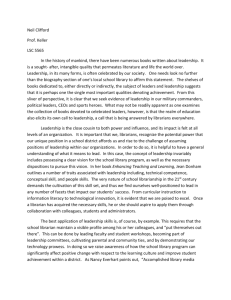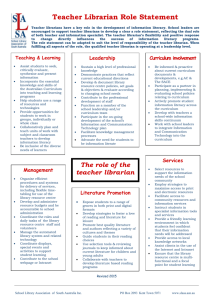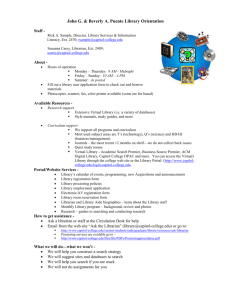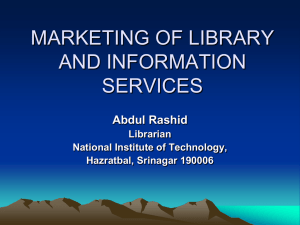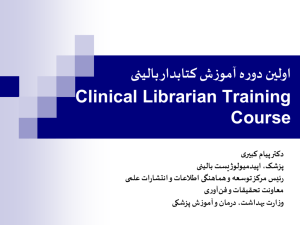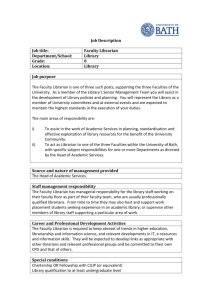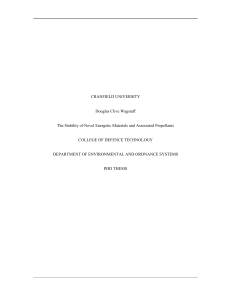The Librarian - rebeccakmiller
advertisement
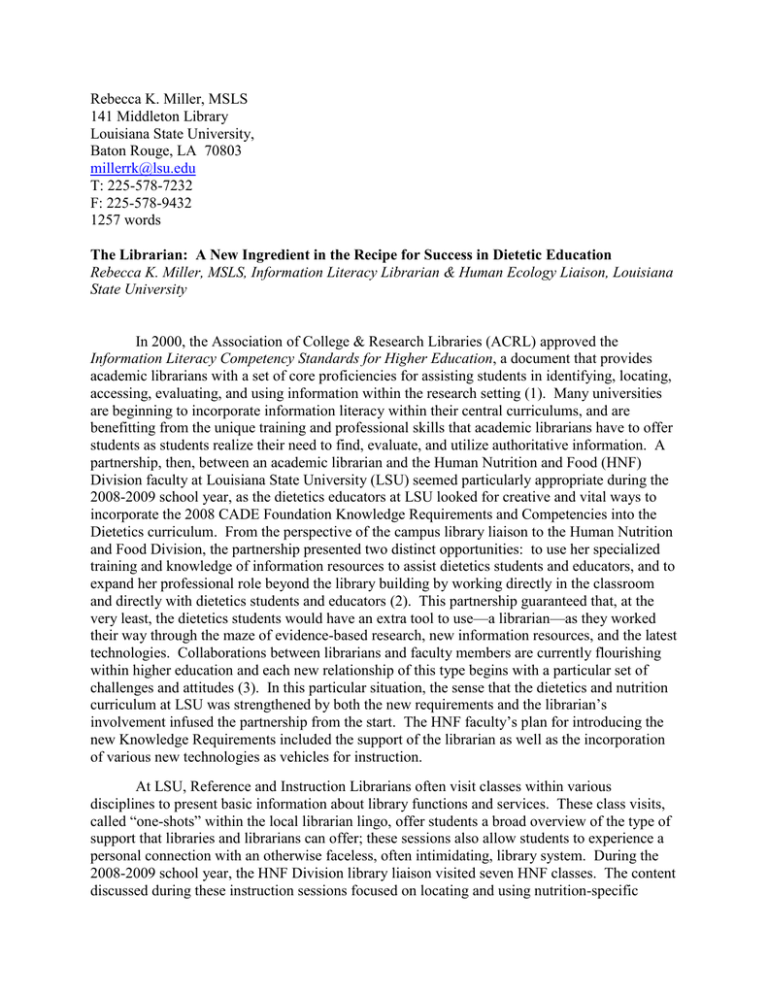
Rebecca K. Miller, MSLS 141 Middleton Library Louisiana State University, Baton Rouge, LA 70803 millerrk@lsu.edu T: 225-578-7232 F: 225-578-9432 1257 words The Librarian: A New Ingredient in the Recipe for Success in Dietetic Education Rebecca K. Miller, MSLS, Information Literacy Librarian & Human Ecology Liaison, Louisiana State University In 2000, the Association of College & Research Libraries (ACRL) approved the Information Literacy Competency Standards for Higher Education, a document that provides academic librarians with a set of core proficiencies for assisting students in identifying, locating, accessing, evaluating, and using information within the research setting (1). Many universities are beginning to incorporate information literacy within their central curriculums, and are benefitting from the unique training and professional skills that academic librarians have to offer students as students realize their need to find, evaluate, and utilize authoritative information. A partnership, then, between an academic librarian and the Human Nutrition and Food (HNF) Division faculty at Louisiana State University (LSU) seemed particularly appropriate during the 2008-2009 school year, as the dietetics educators at LSU looked for creative and vital ways to incorporate the 2008 CADE Foundation Knowledge Requirements and Competencies into the Dietetics curriculum. From the perspective of the campus library liaison to the Human Nutrition and Food Division, the partnership presented two distinct opportunities: to use her specialized training and knowledge of information resources to assist dietetics students and educators, and to expand her professional role beyond the library building by working directly in the classroom and directly with dietetics students and educators (2). This partnership guaranteed that, at the very least, the dietetics students would have an extra tool to use—a librarian—as they worked their way through the maze of evidence-based research, new information resources, and the latest technologies. Collaborations between librarians and faculty members are currently flourishing within higher education and each new relationship of this type begins with a particular set of challenges and attitudes (3). In this particular situation, the sense that the dietetics and nutrition curriculum at LSU was strengthened by both the new requirements and the librarian’s involvement infused the partnership from the start. The HNF faculty’s plan for introducing the new Knowledge Requirements included the support of the librarian as well as the incorporation of various new technologies as vehicles for instruction. At LSU, Reference and Instruction Librarians often visit classes within various disciplines to present basic information about library functions and services. These class visits, called “one-shots” within the local librarian lingo, offer students a broad overview of the type of support that libraries and librarians can offer; these sessions also allow students to experience a personal connection with an otherwise faceless, often intimidating, library system. During the 2008-2009 school year, the HNF Division library liaison visited seven HNF classes. The content discussed during these instruction sessions focused on locating and using nutrition-specific resources, resource evaluation, understanding the peer-review editorial process, and citing resources using the JADA citation style. Search strategies and specific databases (MEDLINE, ISI Web of Science, and CINAHL) were demonstrated and practiced within these sessions. To reinforce the students’ understanding of peer-reviewed material, the librarian facilitated activities where students, in small groups, compared the content and form of a peer-reviewed article with an article that was not peer-reviewed. Similarly, the librarian guided students through exercises that explained citing resources in various information formats using the JADA style. Although these more traditional library instruction sessions seemed to have a positive impact on the students’ understanding of the topics discussed, the HNF faculty members and library liaison wanted to take this traditional library/faculty partnership a bit further and continue to engage the students with matters of research and information literacy. To supplement the library instruction, several new instructional techniques were implemented, which included “e-struction” lessons, the incorporation of Moodle (LSU’s Course Management System), and class-specific wikis. The first supplemental instruction technique evolved an idea that was born over 10 years ago within LSU Libraries. In the 1990s, two LSU librarians collaborated with an environmental management instructor to create an “e-struction” program that used email to push subjectspecific information literacy lessons to students (4). During the 2008-2009 school year, HNF faculty members and their library liaison reworked this idea, providing access to nutritionspecific information literacy lessons and review activities via Moodle. The HNF library liaison created text-based (Word document) lessons, of no more than three, double-spaced pages, that guided students through using the LSU Libraries website and catalog, ISI Web of Science, PubMed/MEDLINE, and CINAH; one of the HNF faculty members wrote a lesson for the ADA Evidence Analysis Library. These lessons were first emailed to the students, and then housed permanently within the class’s Moodle page. Once students read the lesson, which included details about accessing the database, creating specific searches, limiting results, and locating fulltext articles, they were prompted to take a review quiz within Moodle. With the Moodle quiz function, students were able to practice searching within a particular database, and receive immediate feedback on their efforts. Students completed one lesson and review quiz a week, allowing time for each lesson to absorb. These lessons and quizzes ensured that the students were able to personally experience exploring databases within the context of looking for authoritative, nutrition-related research. The other new instructional technology that was employed within this HNF/librarian partnership was the wiki. Although best-known example of a wiki—Wikipedia—isn’t known for its authority, wikis represent ideal tools for scholarly collaboration and communication, since they allow for quick and easy web page editing. There are many wiki platforms that are available for free on the world wide web, such as MediaWiki, WikiSpaces, and TWiki; however, PBWorks (formerly PBWiki), a software program that claims to be as easy to use as it is to make a peanut butter and jelly sandwich, was the software chosen for this particular collaboration, since the librarian had used PBWorks with several other collaborative projects. Essentially, the wiki continued the discussion that was begun during the librarian’s visit to each class. The information on the wiki included the librarian’s personal contact information, as well as a summary of each of the topics covered during the librarian’s visit. When appropriate, the librarian created a wiki page devoted to each of the following topics: database searching, locating full-text articles within the library, understanding the peer-review process, resource evaluation, and citing resources using the JADA style. An example of the wikis used during Spring 2009 can be viewed at: http://huec2110.pbworks.com. The librarian created a wiki, similar to the example, for each specific class that she visited during Spring 2009, and suggested that the wiki be linked into each class’s Moodle page. Students were then able to refer back to the wiki as the semester progressed, easily reminding themselves about the difference between peer-reviewed and non peer-reviewed journals, or how JADA expects websites to be cited. Of the three wikis created during Spring 2009, one of the wikis had been viewed nearly 250 times, and the other two had been viewed approximately 100 times each. Using these various instructional techniques during the 2008-2009 school year, the librarian felt that she established a true rapport with many of the LSU dietetics students. More than 20 individual students and groups of students visited the librarian in her office at the library during the year, and numerous other students carried on email and phone communications her. In the future, the librarian hopes to enhance the supplemental instructional tools in various ways—creating dynamic screen casts for the database demonstrations, for example, and encouraging more student collaboration within the class-specific wikis. She also intends to continue strengthening her relationship with the LSU Human Nutrition and Food students and faculty members, gaining new insights into the unique information needs of dietetics students and helping more students reap the benefits of a working relationship with their campus library and librarian. References 1. Association of College and Research Libraries. Information Literacy Competency Standards for Higher Education. Association of College & Research Libraries Web site. http://www.ala.org/ala/mgrps/divs/acrl/standards/informationliteracycompetency.cfm. Accessed April 16, 2009. 2. Ducas AM, Michaud-Oystryk N. Toward a new venture: Building partnerships with faculty. College & Research Libraries. 2004; 65(4):334-348. 3. Schulte SJ, Sherwill-Navarro PJ. Nursing educators’ perceptions of collaboration with librarians. Journal of the Medical Library Association Journal. 2009; 97(1):56-59. 4. Russo MF, Kelsey S, Walsh M. Online integration of information literacy in an environmental management systems course. In: Zheng R, Ferris SP, eds. Understanding Online Instructional Modeling: Theories and Practices. Hershey, PA: IGI Global, 2008:242-253.

